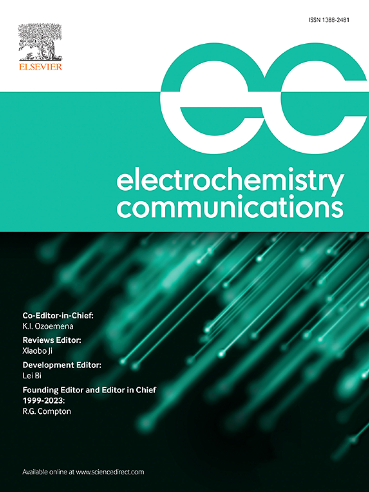三维打印对称超级电容器中具有稳定电化学响应的多孔碳纳米管电极
IF 4.2
3区 工程技术
Q2 ELECTROCHEMISTRY
引用次数: 0
摘要
多壁碳纳米管多孔网络在3D打印对称超级电容器中提供了优异的电容和稳定的电化学响应,该超级电容器是由导电热固性聚乳酸(PLA)集流器熔融沉积建模制成的。这些电极在KOH水溶液中表现出稳定的伏安和恒流响应,而无需对石墨浸渍印刷PLA进行任何预处理。打印的超级电容器显示电容值为~ 80 F g−1,保留率为>; 96%。本文章由计算机程序翻译,如有差异,请以英文原文为准。
Porous carbon nanotube electrodes in 3D printed symmetric supercapacitors with stable electrochemical response
Multi-walled carbon nanotube porous networks offer excellent capacitance and stable electrochemical response in 3D printed symmetric supercapacitors made by fused deposition modelling of conductive thermoset polylactic acid (PLA) current collectors. These electrodes show a stable voltammetric and galvanostatic response with an aqueous KOH electrolyte, without any pretreatment of the graphite-impregnated printed PLA. The printed supercapacitors showed capacitance values of ∼80 F g−1 with a retention of >96 %.
求助全文
通过发布文献求助,成功后即可免费获取论文全文。
去求助
来源期刊

Electrochemistry Communications
工程技术-电化学
CiteScore
8.50
自引率
3.70%
发文量
160
审稿时长
1.2 months
期刊介绍:
Electrochemistry Communications is an open access journal providing fast dissemination of short communications, full communications and mini reviews covering the whole field of electrochemistry which merit urgent publication. Short communications are limited to a maximum of 20,000 characters (including spaces) while full communications and mini reviews are limited to 25,000 characters (including spaces). Supplementary information is permitted for full communications and mini reviews but not for short communications. We aim to be the fastest journal in electrochemistry for these types of papers.
 求助内容:
求助内容: 应助结果提醒方式:
应助结果提醒方式:


